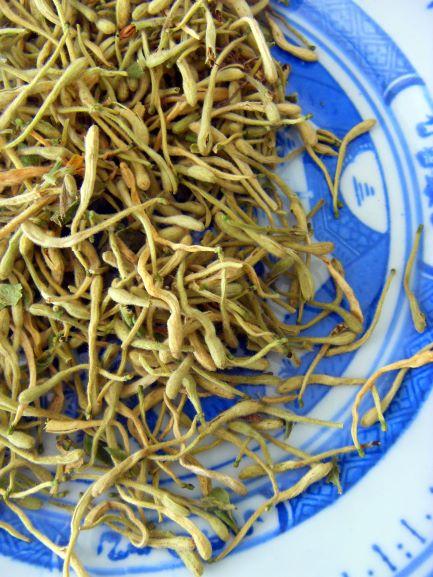Flos Lonicerae
- Name
- Origin
- Where Does It Grow?
- Nature and Flavor
- Identified Active Components / Major Chemical Constituents
- Drug Actions in TCM
- Traditional Uses in TCM
- Pharmacological Actions
- Toxicology
- Administration and Dosage
- Adverse Effect, Side Effects and Cautions
- References

Name
Latin Name: Flos Lonicerae
Common Name: Honeysuckle flower
Scientific Name: Lonicera Japonica
Chinese Name: 金銀花
Pinyin Name: jin yin hua
Origin
The flower bud or newly-bloomed flower of Lonicera japonica Thunb., Lonicera hypoglauca Miq., Lonicera confusa DC., and Lonicera dasystyla Rehd.; plants of the Caprifoliaceae family.1,3
Where Does It Grow?
Honeysuckle flower grows all over China, it is mainly produced in Shandong and Henan provinces.2
Nature and Flavor
Honeysuckle flower is sweet in flavor, cold in nature, and manifests its therapeutic actions in the lung, heart and stomach meridians.3
Identified Active Components / Major Chemical Constituents
Honeysuckle flower mainly contains derivatives of chlorogenic acid, flavones and essential oils.3Drug Actions in TCM
Honeysuckle flower clears heat, eliminates toxic substance, and dissipates wind and heat in the superficial portion of the body (exterior-relieving). 3Traditional Uses in TCM
2.Honeysuckle flower is used in various feverish conditions. For example, it combines with herbs like weeping forsythia capsule, great burdock fruit and peppermint to treat common cold and flu symptoms; gypsum, anemarrhena rhizome and baical skullcap root to reduce high fever. For severe conditions that appear delirium, irritability and red skin patches, the herb can combine with rehmannia root, golden thread rhizome and peony root bark for treatment.
Pharmacological Actions
Toxicology
Administration and Dosage
For decoction, the usual dose of honeysuckle flower is 10~20g each time.4,5
Adverse Effect, Side Effects and Cautions
Honeysuckle flower is not suitable for individuals with a weak digestion, or running sores with watery discharges.3
References
- Li Jiashi (editor-in-chief), Chinese Medicine Identification, Shanghai Scientific and Technical Publishers, 2000-2.
- Nanjing University of Chinese Medicine edited, Dictionary of Chinese Medicine, Shanghai Science and Technology Press, 2005-5
- Lui Daiquan (editor-in-chief), Chinese Herbal Medicine, Shanghai Scientific and Technical Publishers, 2000-6.
- http://www.zysj.com.cn/zhongyaocai/yaocai_j/jinyinhua.html.
- Tao Yufeng, Clinical Herbal Medicine, People's Medical Publishing House, 2005-5.


